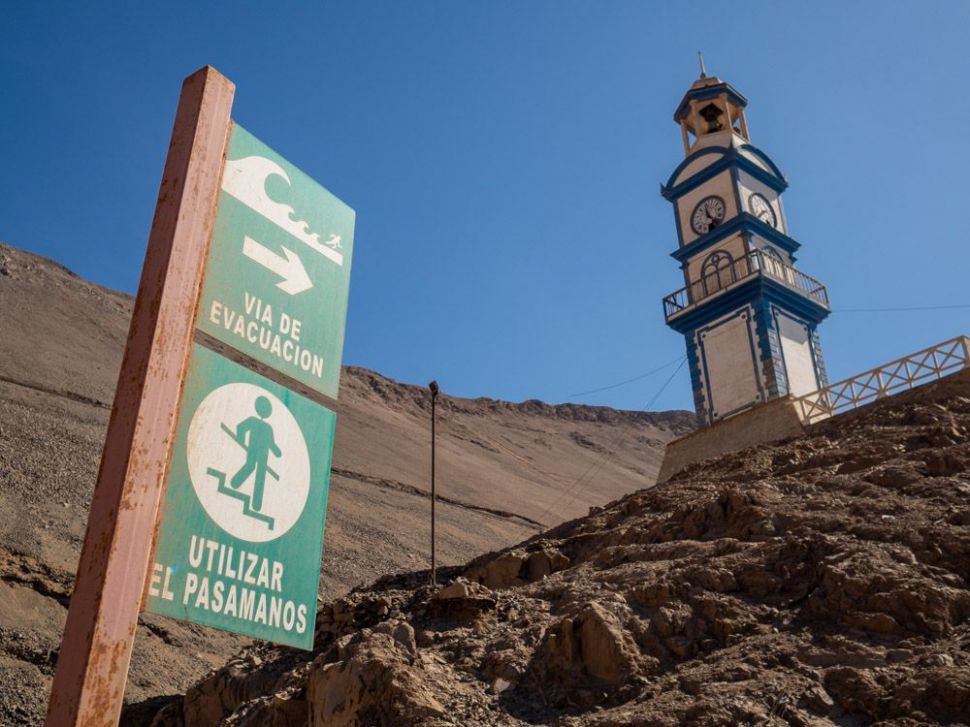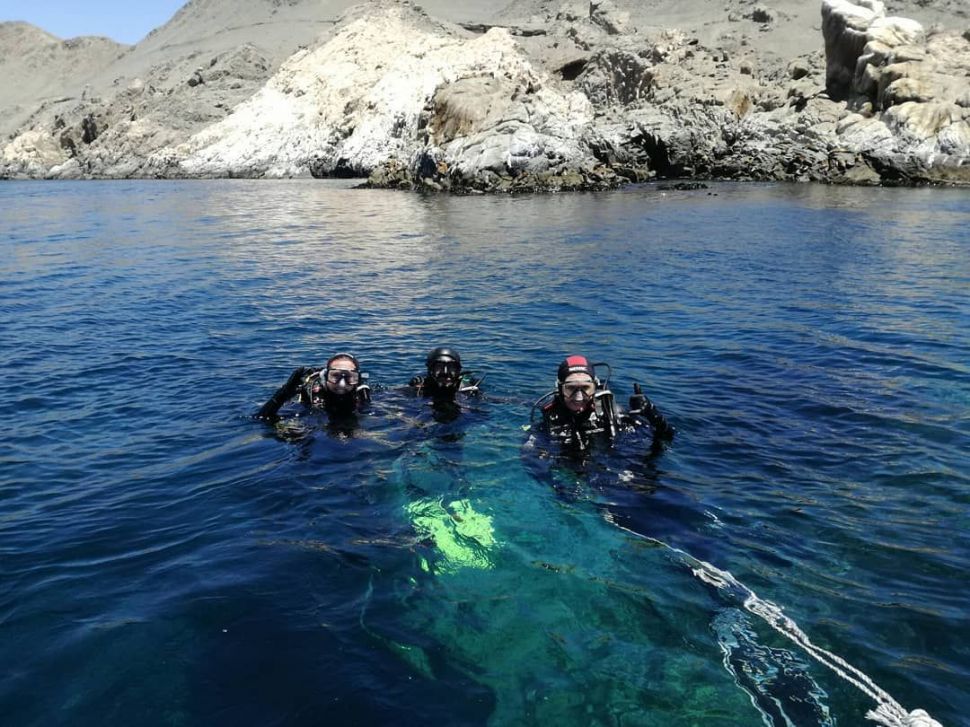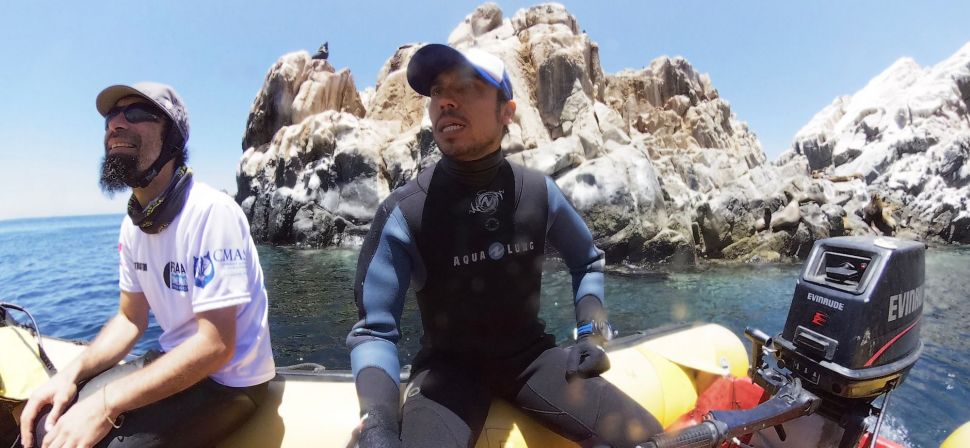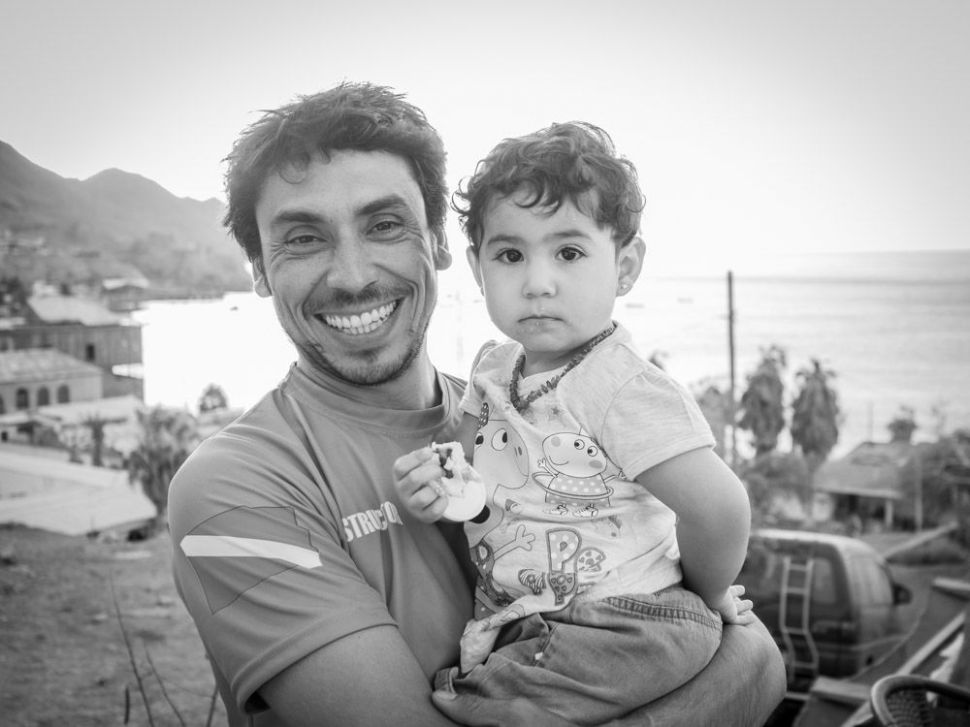
Pisagua: Part II
We return, by bus, to Pisagua a week later. We are unable to resist the temptations of shipwrecks and our first dive in the southern hemisphere. By car, the trip only takes an hour from Iquique to Pisagua. On the bus we rattle around for nearly four hours. When the bus stops in town, we clip into our backpacks and walk down the now familiar main street. Marcos greets us again inside La Roca, and we settle into our seaside room, same as before. The sun hovers above the horizon, signalling the near-end to long Chilean summer days. We confirm our diving plans for the following day with Marcos, and stare excitedly into the beckoning bay before us.

We eat breakfast the following morning, stomachs full of food and anticipation. Marcos moves through the hostel and dive shop with practiced routine, checking off the tasks for the day from an internal list in his head. The other divemaster, Dario, arrives and helps with preparations as well. To remember his name, just remember it’s almost like Mario. Mario, I mean, Dario, waves us down to the small dive shop to fit our equipment. It’s our first time diving in Spanish. We are excited, and perhaps a bit nervous at the challenge. He pulls thick semi-dry suits from a large selection and provides spoken and visually instructions of how to put them on. I’ve worn wetsuits countless times, but these bad boys are thick and I’ve never even seen a semi-dry suit. It’s an unforgiving and restrictive contraption, though I know I will be glad to have it in the cold water.

After way too much time struggling to get suited up for our adventure, the tanks and a few other gear bags are loaded into the small, inflatable yellow boat we will take on the water. It is towed by an ancient, dark green mini van decorated with scuba stickers. The radio has been torn out and wires hang in strange places from the dash. This van’s had a hard life, but always gets the job done… when it starts.
Marcos and Dario wave as we drive through town, stopped to exchange greetings with a few friends. We feel like a spectacle in our big van towing a bright yellow boat down the small main street. The pier is undergoing maintenance by a technical diver underwater, so it takes some effort from surrounding workers for us to get the boat ready to hit the water. Everyone around the pier gathers to be part of the action. I imagine Maros is somewhat of a celebrity in Pisagua with a boat meant for something other than fishing. Our friend from our previous visit Walter with the old-fashioned cameras, lingers around the pier camera in hand, snapping photos as the crew hoists the inflatable dinghy with a small crane and lower her into the water. I carry a full tank down rusty metals steps, and a construction worker helps pass the tank to the boat. I can’t help thinking this is already one of the most interesting diving experiences I’ve had. Usually I’m not speaking in Spanish, wearing a semi-dry suit, nor prepping from a fishing pier built over freezing water with a technical diver beneath us doing underwater welding.
As Marcos twists the throttle, the boat reaches plane position, or as much as it can holding four people and a ridiculous amount of equipment. I love the sound of the water along the boat, watching our wake push across the open water. The wind blows my face into a smile. Soon, we arrive at the first dive site. The jagged shore erupts from the water close by, and growing the first flat stretch of land is a large cemetery. The seaside desert environment melded all the crosses and wooden markers planted there to transform into the same faded and dry façade. I stare briefly at the cemetery, recalling our visit to this place on our first trip to Pisagua. It is beautiful and eery, and it marks locations of some of the most infamous events during Pinochet’s reign. It seems sadly fitting there is a shipwreck just within sight of the cemetery.

We force ourselves into our gear, greatly encumbered by the thick suits. We fall off the side of the boat into the chilling water. Marcos ensures we are ready to dive, and we descent. I’m immediately grateful for our days diving in Bonaire. Although this experience couldn’t be more different, I’m glad I feel practiced and can focus my attention of the feel of the new environment, managing my energy in the cold water, and navigating the unyielding currents.
From a wall of green water, the ghostly image of a ship begins to penetrate the monochrome view. I remember no sailors actually went down with this ship when it caught fire in 1883, during the War of the Pacific, so no aquatic ghosts to worry about. La Limeña was a large warship of the time, powered by a steam engine which turned giant paddles on both her starboard and port side.
Barnacles of all sizes cling to the foreign structures laying in contrast to the rocky ocean floor. Fish idly swim around us, and we swim past starfish with countless legs. As we float over different parts of the ship, I try to absorb the scale and grandeur of La Limeña. Marcos safely guides us all around the wreck, point and signing what we are seeing along the way.
When it is time to resurface, I don’t want to leave the wreck but I don’t mind a break from the cold water. We follow Marcos back to the boat, anchored nearby. I find it to be tricky getting back in the boat, but I manage it with one strong push along the side of the raft and plenty of help pulling me over the side. We marvel at we we’ve just seen, asking questions, and gesticulating excitedly as the result from one of the most uniques dives we’ve ever done. We secure the gear within the boat, and point the bow across the bay towards our next dive site. Marcos leads a winding course to our destination, showing off secluded beaches and strange rock formations jutting from the water.

Our tour continues after we wait for the nitrogen levels in our blood to decrease. We enter the water for a final dive. We pass colonies of sea lions, or lobos marinos (literally translated, “marine wolves”), and even spotting a few members of the rarer South American fur seal. The noise of the sea lions yelling at one another, occasionally fighting for a coveted sun spot on the rocks, startles at first. Suddenly, Marcos calls out “pingüinos”! Tucked into the gelatinous colony of sunbathing sea lions are three lonely Humboldt penguins. They stand proudly, seemingly gazing across the waterfront, awkwardly flapping their wings. From beak to webbed foot, they only measure 18” tall and look comical next to the giant beasts sprawled across most of the rocky surface. I’ve never seen penguins in the wild. I’m thrilled by our luck, and can hardly believe where we are and what we are doing at this beautiful, yet noisy, moment.

Marcos and Dario anchor the boat and we break for cookies and apple juices. I laugh out loud to the more ridiculous sea lion calls and when they lazily flop back into the water. Looking to the sea lions and penguins, I can hardly imagine how they maneuver their aquarian bodies up and over the towering rocks. Our snack break is further distracted by a school of the biggest jellyfish I’ve ever seen. Their peachy-white forms float silently beneath the boat. We stare in awe of the hundreds we see from the surface. I wonder how quickly they will pass.
The jellyfish disappear almost as quickly as they graced our presence and it’s time to descend once again. We gear up, perhaps a bit faster and more skilled than the last time. I don my hood, smiling because until today I’ve never dove in water cold enough to warrant one. Dario takes the lead with this dive, and Marcos helps us with final preparations before we fall backwards off the boat, reuniting with the chilled water.

Now I maneuver myself down to the desired depth much easier, understandings the weight differences of my equipment opposed to most every other dive of my life. At forty feet down, we settle on a bed of empty shells stretching out in every direction around the rocky towers that rise to the surface. Lane stand flat-footed at the bottom, arms crossed from the cold rather than disinterest.
A sea lion, emanating a grace almost unfathomable seeing them on land, sneaks behind Lane curiously and darts away. Lane couldn’t feel the water move and is none the wiser. I smile in the way you smile with scuba diving—teeth clenched to the regulator and my eyes revealing a sliver of emotion. Dario, our guide for this dive, leads us further into a granite-looking channel between two of the sea lion islands. We follow the current over a dancing kelp forest at the bottom of this purple channel. Sea lions, in numbers I can’t manage to count fly from the surface down to us and stare before swimming back up to relay news to their pals. We watch them for over half and hour as we swim and sometimes cling lightly to the large rocks on the ocean floor. Dario spots and introduces us to other sea creatures as we absorbs the craziness of this little spot of the ocean world.
We swim back from the channel, at times floating mercilessly with the current, the sea lions continue following us. Sometimes, I turn around to see one darting away. I’m never fast enough to sneak a peek of them following me. I am cold, but I don’t care. My left ear begins to ache in protest of prolonged submersion so I enjoy watching the sea lions play from whatever depth my body will allow. I am almost close enough to see their eyes in full detail—the layers, colors, and lenses making their marine existence possible. This channel of purple jagged rocks dotted with starfish, the rusty green kelp swaying, the silhouettes of the sea lions near the surface, and the bubbles swirling around a curious sea lion as she descends towards us is one of the most beautiful sights I’ve ever seen.
Like so many times in Latin America, I yearn for the ability to express my gratitude for an experience more to the kind person who gave it to me. I hope my smile conveys what my Spanish cannot. Marcos gently laughs at our reaction to both the dives. He knows we now understand why he is here—why he loves this place. Marcos is a marine biologist of sorts and studies various aquatic populations along the coast. Depending on the season, he monitors the thousands of sea lions, schools of finger-sized fish, or the migrating whales, just to name a few.

We zoom across the water and unload, then beach the boat nearby. I am covered in sand, my hair pointing in every direction, and am I so incredibly happy. We return to_La Roca_, where Marcos’s wife is holding their two-year old daughter, Emma. She is sweet and friendly, with curly, black locks framing a gentle face.
After a meal and a bit of rest, I find Marcos inside. He meets me at his desks and helps me to record all the data for our dives to add to our log. He gifts me a poster and small pamphlet detailing the fauna of the area. I think it’s a wonderful thing to travel and meet so many people so passionate about so many places, ready and willing to share them with you. I am grateful to find one such place and one such person in this small seaside desert town.
As Marcos answer a few more questions, Emma rushes into the room, cookie in hand and cooing for attention. We laugh and Marcos scoops her in his arms, sucking a cookie crumb off her cheek. He tells me how she loves the water and always wants to visit the beach in town. I think how beautiful Emma’s childhood will be in this treasure of a town tucked away in Chile: learning to dive on shipwrecks, amongst sea lions and dolphin pods, and counting the whales with her father.
As grateful as am I when people introduce to the place which captures their heart, I am ever more grateful when people trust and welcome us into their daily lives.

